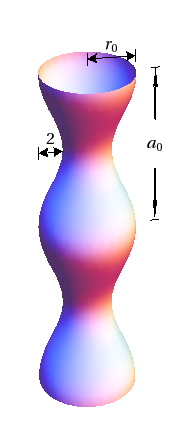The sphere of radius \(7\) is defined in spherical coordinates by the equation \(\rho = 7\text{.}\) So, on the sphere, \(\rho\) is a function of the other two variables, \(\phi\) and \(\theta\text{.}\) We use those as the variables in our parametrization:
\begin{align*}
x(\phi,\theta) \amp = 7 \sin\phi \cos\theta \\
y(\phi,\theta) \amp = 7 \sin\phi \sin\theta \\
z(\phi,\theta) \amp = 7 \cos \phi
\end{align*}
i.e.,
\begin{equation*}
\mathbf{r}(\phi,\theta) = \langle 7\sin\phi\cos\theta, 7\sin\phi\sin\theta, 7 \cos\phi \rangle.
\end{equation*}
And the domain of our parametrization is \(0\le \phi \le \pi\text{,}\) \(0 \le \theta \le 2\pi\text{.}\) Taking partial derivatives, we get
\begin{align*}
\mathbf{r}_\phi \amp = \langle 7 \cos\phi \cos\theta, 7\cos\phi\sin\theta, -7\sin\phi \rangle \\
\mathbf{r}_\theta \amp = \langle -7\sin\phi\sin\theta, 7\cos\phi\cos\theta, 0 \rangle
\end{align*}
Exercise Compute the cross product of \(\mathbf{r}_\phi\) and \(\mathbf{r}_\theta\) and show that it simplifies to
\begin{equation*}
7^2 \sin\phi \langle \cos\theta \sin\phi, \sin\theta \sin\phi, \cos\phi \rangle.
\end{equation*}
Then use trig identities to show that the vector \(\langle \cos\theta \sin\phi, \sin\theta \sin\phi, \cos\phi \rangle\) is a unit vector.
Using the result of the Exercise, we have the following formula for the integrand in the surface area integral.
\begin{equation*}
| \mathbf{r}_\phi \times \mathbf{r}_\theta| = 7^2 \sin\phi
\end{equation*}
(It is worth noting that this quantity is always nonnegative for
\begin{equation*}
\phi
\end{equation*}
between
\begin{equation*}
0
\end{equation*}
and
\begin{equation*}
\pi\text{!}
\end{equation*}
) Now we can set up the double integral:
\begin{align*}
\mathrm{surface~area} \amp = \iint\limits_{[0,\pi]\times[0,2\pi]} |\mathbf{r}_\phi \times \mathbf{r}_\theta|\,dA \\
\amp = \int\limits_{\theta=0}^{2\pi} \int\limits_{\phi = 0}^\pi 7^2 \sin\phi\, d\phi\,d\theta
\end{align*}
Exercise Compute the integral. Your answer should be
\(4\pi\cdot 7^2\text{.}\)
There was nothing special about
\(7\) in this example. Redoing the example, replacing every
\(7\) with an
\(R\text{,}\) we would show that the surface area of a sphere of radius
\(R\) is
\(4\pi R^2\text{.}\)
